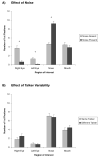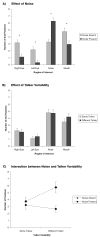The effect of varying talker identity and listening conditions on gaze behavior during audiovisual speech perception
- PMID: 18621032
- PMCID: PMC2630206
- DOI: 10.1016/j.brainres.2008.06.083
The effect of varying talker identity and listening conditions on gaze behavior during audiovisual speech perception
Abstract
During face-to-face conversation the face provides auditory and visual linguistic information, and also conveys information about the identity of the speaker. This study investigated behavioral strategies involved in gathering visual information while watching talking faces. The effects of varying talker identity and varying the intelligibility of speech (by adding acoustic noise) on gaze behavior were measured with an eyetracker. Varying the intelligibility of the speech by adding noise had a noticeable effect on the location and duration of fixations. When noise was present subjects adopted a vantage point that was more centralized on the face by reducing the frequency of the fixations on the eyes and mouth and lengthening the duration of their gaze fixations on the nose and mouth. Varying talker identity resulted in a more modest change in gaze behavior that was modulated by the intelligibility of the speech. Although subjects generally used similar strategies to extract visual information in both talker variability conditions, when noise was absent there were more fixations on the mouth when viewing a different talker every trial as opposed to the same talker every trial. These findings provide a useful baseline for studies examining gaze behavior during audiovisual speech perception and perception of dynamic faces.
Figures






References
-
- Althoff RR, Cohen NJ. Eye-movement-based memory effect: a reprocessing effect in face perception. J Exp Psychol Learn. 1999;25:997–1010. - PubMed
-
- Ambadar Z, Schooler JW, Cohn JF. Deciphering the enigmatic face: The importance of facial dynamics in interpreting subtle facial expressions. Psychol Sci. 2005;16:403–410. - PubMed
-
- Baron-Cohen S, Wheelwright S, Hill J, Raste Y, Plumb I. The “Reading the mind in the eyes” test revised version: a study with normal adults, and adults with Asperger syndrome or high-functioning autism. J Child Psychol Psychiatr. 2001;42:241–251. - PubMed
-
- Barton J, Radcliffe N, Cherkasova M, Edelman J, Intriligator J. Information processing during face recognition: the effects of familiarity, inversion and morphing on scanning fixations. Perception. 2006;353:1089–1105. - PubMed
-
- Benoît C, Guiard-Marigny T, Le Groff B, Adjoudani A. Which components of the face do humans and machines best speechread? In: Stork DG, Hennecke M, editors. Speechreading by Humans and Machines: Models, Systems & Applications. Kluwer Academic Publishers; 1996.
Publication types
MeSH terms
Grants and funding
LinkOut - more resources
Full Text Sources

